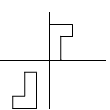Decoding transformations
Problem
In this question, each of the letters $I$, $R$, $S$ and $T$ represents a different transformation.
We can do one transformation followed by another. For example, $R S$ means ``do $R$, then $S$''.
We can also undo transformations. For example, $R^{-1}$ means ``do the inverse (opposite) of $R$''.
Here are the effects of some transformations on a shape. Can you describe the transformations $I$, $R$, $S$ and $T$?




What single transformation has the same effect as $R S T I R^{-1}S^{-1}T^{-1}I^{-1}$?
This problem is the first of three related problems.
The follow-up problems are Combining Transformations and Simplifying Transformations .
Getting Started
Student Solutions
We received many correct solutions describing each of the transformations. Well done Rahel from Dartford Grammar School for Boys, Harry from Culford, Dominic, Ellie, Finn and Max from Brenchley andMatfield Primary School, Jannis from Long Bay, Ben from the Perse School and Emilio from St Peter's College.
However, the second part caught almost everyone out: since it looked like the first four transformations were "undone" by their inverses, most people thought that the string of transformations returned the original shape back to where it started.
Only Emilio managed to work out that this was not the case:

$R$ reflects the figure vertically.
$S$ rotates it 90 degrees clockwise.
This leaves the figure like this:

$T$ translates the figure 1 right:
$I$ will do nothing.
$R^{-1}$ reflects the figure again because inverse reflections are the same as the original reflection.
$S^{-1}$rotates the figure $90^\circ$ anticlockwise:
$T^{-1}$ will translate the figure left one square.

$I$ does nothing, so $I^{-1}$ will do nothing.
Therefore a rotation of $180^\circ$ round (-0.5, -0.5) will have the same result as $R S T I R^{-1}S^{-1}T^{-1}I^{-1}$

Well done Emilio.
Editor's note:
Teachers' Resources
This problem is the first of three related problems.
The follow-up problems are Combining Transformation and Simplifying Transformations .
We have adopted the convention of listing a sequence of transformations from left to right; teachers may want to mention to their students that in other contexts a sequence of transformations may be listed from right to left.
